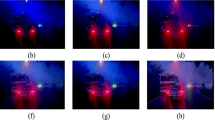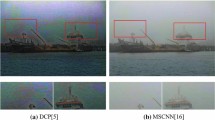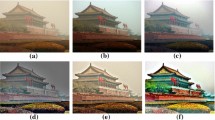Abstract
Traditional dehazing methods based on restoration are prone to color distortion and noise amplification when dealing with hazy image with large sky area. To improve dehazing effect, we propose a dehazing algorithm based on image structure–texture decomposition and reconstruction. Hazy image is decomposed into high-frequency texture layer and low-frequency structure layer by total variation. Discrete cosine transform is used to generate an image mask to separate sky area and non-sky area. The texture layer is denoised by the mask, and the structure layer is dehazed by dark channel prior. The media transmission is corrected by color attenuation prior. Finally, the denoised texture layer and the dehazed structure layer are reconstructed to obtain the dehazed image. A no-reference image quality assessment is also proposed to evaluate the dehazed images. Experiment results show that, compared with the state-of-the-art methods, our algorithm has better dehazing effect on non-sky area, and the sky area after dehazing is smooth without color distortion and noise.
















Similar content being viewed by others
References
Kim, J.Y., Kim, L.S., Hwang, S.H.: An advanced contrast enhancement using partially overlapped sub-block histogram equalization. IEEE Trans. Circuits Syst. Video Technol. 11(4), 475–484 (2001). https://doi.org/10.1109/76.915354
Arici, T., Dikbas, S., Altunbasak, Y.: A histogram modification framework and its application for image contrast enhancement. IEEE Trans. Image Process. 18(9), 1921–1935 (2009). https://doi.org/10.1109/TIP.2009.2021548
Gao, Y., Hu, H.M., Wang, S., et al.: A fast image dehazing algorithm based on negative correction. Signal Process. 103(10), 380–398 (2014). https://doi.org/10.1016/j.sigpro.2014.02.016
Lian, X., Pang, Y., Yang, A.: Learning intensity and detail mapping parameters for dehazing. Multimed. Tools Appl. 77(12), 15695–15720 (2018). https://doi.org/10.1007/s11042-017-5142-7
Wang, Y., Wang, H., Yin, C., et al.: Biologically inspired image enhancement based on retinex. Neurocomputing 177, 373–384 (2016). https://doi.org/10.1016/j.neucom.2015.10.124
Galdran A, Alvarez-Gila A, Bria A, et al, On the duality between retinex and image dehazing, In: Proceedings of the IEEE Conference on Computer Vision and Pattern Recognition, Salt Lake City, UT, USA, 2018, pp. 8212–8221.
Ancuti, C.O., Ancuti, C.: Single image dehazing by multi-scale fusion. IEEE Trans. Image Process. 22(8), 3271–3282 (2013). https://doi.org/10.1109/TIP.2013.2262284
Choi, L.K., You, J., Bovik, A.C.: Referenceless prediction of perceptual fog density and perceptual image defogging. IEEE Trans. Image Process. 24(11), 3888–3901 (2015). https://doi.org/10.1109/TIP.2015.2456502
Galdran, A., Vazquez-Corral, J., Pardo, D., et al.: Fusion-based variational image dehazing. IEEE Signal Process. Lett. 24(2), 151–155 (2017). https://doi.org/10.1109/LSP.2016.2643168
Wang, J.B., He, N., Zhang, L.L., Lu, K.: Single image dehazing with a physical model and dark channel prior. Neurocomputing 149, 718–728 (2015). https://doi.org/10.1016/j.neucom.2014.08.005
Zhu, Q., Mai, J., Shao, L.: A fast single image haze removal algorithm using color attenuation prior. IEEE Trans. Image Process. 24(11), 3522–3533 (2015). https://doi.org/10.1109/TIP.2015.2446191
Lai, Y.H., Chen, Y.L., Chiou, C.J., et al.: Single-image dehazing via optimal transmission map under scene priors. IEEE Trans. Circuits Syst. Video Technol. 25(1), 1–14 (2014). https://doi.org/10.1109/TCSVT.2014.2329381
Berman D, Avidan S, Non-local image dehazing, In: Proceedings of the IEEE conference on computer vision and pattern recognition, Las Vegas, NV, USA, 2016, pp. 1674–1682.
Chen, C., Do, M.N., Wang, J.: Robust image and video dehazing with visual artifact suppression via gradient residual minimization. In: Leibe, B., Matas, J., Sebe, N., Welling, M. (eds.) Computer Vision – ECCV 2016: 14th European Conference, Amsterdam, The Netherlands, October 11-14, 2016, Proceedings, Part II, pp. 576–591. Springer International Publishing, Cham (2016). https://doi.org/10.1007/978-3-319-46475-6_36
Ju, M., Zhang, D., Wang, X.: Single image dehazing via an improved atmospheric scattering model. Vis. Comput. 33(12), 1613–1625 (2017). https://doi.org/10.1007/s00371-016-1305-1
Bui, T.M., Kim, W.: Single image dehazing using color ellipsoid prior. IEEE Trans. Image Process. 27(2), 999–1009 (2017). https://doi.org/10.1109/TIP.2017.2771158
Salazarcolores, S., Cabalyepez, E., Ramosarreguin, J.M., et al.: A fast image dehazing algorithm using morphological reconstruction. IEEE Trans. Image Process. 28(5), 2357–2366 (2018). https://doi.org/10.1109/TIP.2018.2885490
Shiliang, G., Yuanyuan, et al.: Detail preserved single image dehazing algorithm based on airlight refinement. IEEE Trans. Multimed. 21(2), 351–362 (2019). https://doi.org/10.1109/TMM.2018.2856095
Wu, Q., Zhang, J., Ren, W., et al.: Accurate transmission estimation for removing haze and noise from a single image. IEEE Trans. Image Process. 29, 2583–2597 (2020). https://doi.org/10.1109/TIP.2019.2949392
Cai, B., Xu, X., Jia, K., Qing, C., Tao, D.: Dehazenet: an end-to-end system for single image haze removal. IEEE Trans. Image Process. 25(11), 5187–5198 (2016). https://doi.org/10.1109/TIP.2016.2598681
Ren, W., Liu, S., Zhang, H., et al.: Single image dehazing via multi-scale convolutional neural networks. In: Leibe, B., Matas, J., Sebe, N., Welling, M. (eds.) Computer Vision – ECCV 2016: 14th European Conference, Amsterdam, The Netherlands, October 11-14, 2016, Proceedings, Part II, pp. 154–169. Springer International Publishing, Cham (2016). https://doi.org/10.1007/978-3-319-46475-6_10
Li B, Peng X, Wang Z, Xu J, Feng D, Aod-net: All-in-one dehazing network, In: Proceedings of the IEEE international conference on computer vision,Venice, Italy, 2017, pp. 4770–4778.
Park, J., Han, D.K., Ko, H.: Fusion of heterogeneous adversarial networks for single image dehazing. IEEE Trans. Image Process. 29, 4721–4732 (2020). https://doi.org/10.1109/TIP.2020.2975986
Hautiere, N., Tarel, J.P., Aubert, D., et al.: Blind contrast enhancement assessment by gradient ratioing at visible edges. Image Anal. Stereol. 27(2), 87–95 (2008). https://doi.org/10.5566/ias.v27.p87-95
Hashim, A.R., et al.: No reference image quality measure for hazy images. Int. J. Intell. Eng. Syst. 13(6), 460–471 (2020). https://doi.org/10.22266/ijies2020.1231.41
Min, X., et al.: Quality evaluation of image dehazing methods using synthetic hazy images. IEEE Trans. Multimed. 21(9), 2319–2333 (2019). https://doi.org/10.1109/TMM.2019.2902097
Qin, M., Xie, F., Jiang, Z.: No reference assessment of image visibility for dehazing. In: Zhao, Y., Kong, X., Taubman, D. (eds.) Image and graphics: 9th international conference, ICIG 2017, Shanghai, China, September 13-15, 2017, Revised Selected Papers, Part I, pp. 664–674. Springer International Publishing, Cham (2017). https://doi.org/10.1007/978-3-319-71607-7_58
Ren X, Tang C, Wang B, et al: Single Image with Large Sky Area Dehazing Based on Structure-texture Decomposition, In: IEEE 6th International Conference on Computer and Communications (ICCC). IEEE, Chengdu, China, 2020,pp. 415–419.
McCartney, E.J.: Optics of the atmosphere: scattering by molecules and particles. Optica Acta Int. J. Optics 24(7), 779–779 (1977)
He, K., Sun, J., Tang, X.: Single image haze removal using dark channel prior. IEEE Trans. Pattern. Anal. Mach. Intell. 33(12), 2341–2353 (2011). https://doi.org/10.1109/TPAMI.2010.168
Aujol, J.F., Gilboa, G., Chan, T., Osher, S.: Structure-texture image decomposition: modeling, algorithms, and parameter selection. Int. J. Comput. Vis. 67(1), 111–136 (2006). https://doi.org/10.1007/s11263-006-4331-z
Wang, Y., Yang, J., Yin, W., Zhang, Y.: A new alternating minimization algorithm for total variation image reconstruction. SIAM J. Imaging Sci. 1(3), 248–272 (2008). https://doi.org/10.1137/080724265
Li, Y., Guo, F., Tan, R.T., Brown, M.S.: A contrast enhancement framework with JPEG artifacts suppression. In: Fleet, D., Pajdla, T., Schiele, B., Tuytelaars, T. (eds.) Computer vision:ECCV 2014: 13th European Conference, Zurich, Switzerland, September 6-12, 2014, Proceedings, Part II, pp. 174–188. Springer International Publishing, Cham (2014). https://doi.org/10.1007/978-3-319-10605-2_12
Li, X., Cewu, L., Yi, X., Jia, J.: Image smoothing via L0 gradient minimization. ACM Trans. Graphics 30(6), 1–12 (2011). https://doi.org/10.1145/2070781.2024208
Li, X., Chen, M., Nie, F., Wang, Q.: A multiview-based parameter free framework for group detection. Proc. AAAI Conf. Artif. Intell. (2017). https://doi.org/10.1609/aaai.v31i1.11208
Panetta, K., Agaian, S., Zhou, Y., et al.: Parameterized logarithmic framework for image enhancement. IEEE Trans. Syst. Man Cyber. Part B 41(2), 460–473 (2011). https://doi.org/10.1109/TSMCB.2010.2058847
Meng G, Wang Y, Duan J, et al: Efficient Image Dehazing with Boundary Constraint and Contextual Regularization, In: IEEE International Conference on Computer Vision, Sydney, NSW, Australia, 2013, pp. 617–624.
L. K. Choi, J. You, and A. C. Bovik, "LIVE Image Defogging Database," Online: http://live.ece.utexas.edu/research/fog/fade_defade.html, 2015.
Acknowledgements
This work was supported by the Key Research and Development Programs of Jiangsu Province (BE2018720), and the Open project of Engineering Center of Ministry of Education (NJ2020004).
Author information
Authors and Affiliations
Corresponding author
Additional information
Publisher's Note
Springer Nature remains neutral with regard to jurisdictional claims in published maps and institutional affiliations.
Rights and permissions
About this article
Cite this article
Tang, C., Jia, R., Ren, X. et al. Structure–texture decomposition-based dehazing of a single image with large sky area. Machine Vision and Applications 33, 72 (2022). https://doi.org/10.1007/s00138-022-01321-x
Received:
Revised:
Accepted:
Published:
DOI: https://doi.org/10.1007/s00138-022-01321-x




